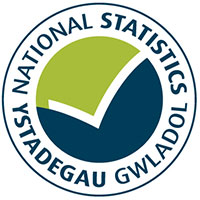Data on tests, new incidents, restricted herds and cattle slaughtered with bovine TB for December 2023.
This is not the latest release in the series: Incidence of tuberculosis (TB) in cattle in Great Britain
The Department for Environment, Food and Rural Affairs (Defra) Statistics release, on which this statistical headline is based, includes statistics on the basis of the Wales TB areas.
New TB herd incidents
Figure 1: New herd incidents in Wales, January 2008 to December 2023
Description of Figure 1: A line and bar chart showing the trend in new herd incidents in Wales since 2008. The light blue bars indicate the monthly number of new incidents while the dark line indicates the 12-month rolling average of new incidents.
There were 618(r) new incidents in the 12 months to December 2023, an increase of 2.8%(r) compared with the previous 12 months when there were 601(r) new incidents.
Source: Defra bovine TB statistics published on 20 March 2024.
Animals slaughtered for TB control
Figure 2: Animals slaughtered in Wales, January 2008 to December 2023
Description of Figure 2: A line and bar chart showing the trend in animals slaughtered in Wales since 2008. The light blue bars indicate the monthly number of animals slaughtered while the dark line indicates the 12-month rolling average of animals slaughtered.
There were 10,299 animals slaughtered in the 12 months to December 2023, an increase of 8.2% compared with the previous 12 months when there were 9,515 animals slaughtered.
Source: Defra bovine TB statistics published on 20 March 2024.
Further information
The overall trend for animals slaughtered due to bovine TB control is variable. Much of the rise since 2014 is attributable to increased use of high-sensitivity testing. For example, gamma-testing, removal of Inconclusive Reactors (IRs) and severe interpretation of the skin test have all been used with the intention of clearing up infection and reducing the risk of the disease spreading and breakdowns recurring.
The monthly series is variable, and peaks can be expected from time to time. There had been an increase in the trend since the peak in October 2018 was reached, this has since fallen. Further analysis of this trend up to June 2019 has been published in the statistical article: Analysis on the number of animals slaughtered due to bovine TB controls, October 2018 to June 2019.
Contact
Jimmy Webster
Email: stats.agric@gov.wales
Rydym yn croesawu gohebiaeth yn Gymraeg / We welcome correspondence in Welsh.
Media
Telephone: 0300 025 8099
Rydym yn croesawu galwadau yn Gymraeg / We welcome calls in Welsh.

